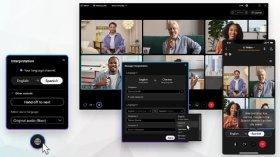
Cisco introduces digital accessibility features for Webex
Cisco aims the latest features at making Webex friendlier to disabled people, an essential step as digital accessibility lawsuits rise and the fight for talent intensifies.
Cisco has unveiled features intended to make Webex more accessible as businesses are under increasing legal and government pressure to accommodate disabled workers.
The company this week improved sign-language interpretation in Webex, increased the number of languages the collaboration software can transcribe, and made audio improvements that help people who are hard of hearing. The changes will help businesses avoid digital accessibility lawsuits and attract a broader pool of talent, analysts said.
Companies must make it easier for disabled workers to access digital services as the threat of litigation has grown. Businesses face a rising number of lawsuits claiming apps and websites are unavailable to people with disabilities.
According to a December report by accessibility-tool developer UsableNet, U.S. courts received more than 4,000 digital accessibility suits in 2021, compared with about 3,500 in 2020 and nearly 2,900 in 2019. In one recent example, payroll giant ADP settled a lawsuit that claimed blind and low-vision workers could not access the company's products.
"Prioritizing accessibility isn't just about widening your talent pool or improving employee experience," said Forrester Research analyst Gina Bhawalkar. "It's also a smart risk mitigation strategy."
Businesses also must contend with upcoming accessibility legislation. The European Accessibility Act (EAA), meant to standardize regulations across EU countries, will force apps and websites to accommodate disabled people throughout 27 member states. By June, EU countries must adapt EAA-compliant laws and begin enforcing those laws by mid-2025.

Features that increase access for disabled workers can help everyone. IDC analyst Wayne Kurtzman said videoconferencing vendors introduced closed captioning for deaf and hard-of-hearing employees, but many non-disabled workers use the capability to help them follow meetings.
"Many of these accessibility enhancements will have benefits that help more than the communities for which they were designed," he said.
Cisco taking its Webex transcription engine to more languages will help foreign workers and people who are deaf or hard of hearing. The product currently supports only English, but the company plans to add 12 languages.
Once transcribed, Webex can translate the captions into more than 100 languages. Cisco did not provide a date for the feature or list the additional languages.
Zoom, Microsoft Teams and BlueJeans by Verizon offer closed captioning, but only for English.
In February, Cisco will also launch a feature called "optimize for all voices" that makes it easier to hear meeting participants who are far away from the microphone. The technology uses AI to filter out background noise and make attendee voices clearer, which should help hearing-challenged employees and others follow a meeting.
Teams and Zoom offer noise suppression, but not a feature that enhances background attendee voices.
Finally, Cisco has improved the way foreign-language and sign-language interpretation works in Webex. Meetings and webinars now support channels for up to 110 interpreters, and a new icon helps attendees discern interpreters from panelists and fellow participants.
When attendees join a meeting, they can select their preferred language and control the audio balance between the meeting's featured speaker and their interpreter.
Zoom allows for only 20 designated interpreters in a meeting. Teams does not have a similar role for meetings.
Mike Gleason is a reporter covering unified communications and collaboration tools. He previously covered communities in the MetroWest region of Massachusetts for the Milford Daily News, Walpole Times, Sharon Advocate and Medfield Press. He has also worked for newspapers in central Massachusetts and southwestern Vermont and served as a local editor for Patch. He can be found on Twitter at @MGleason_TT.







